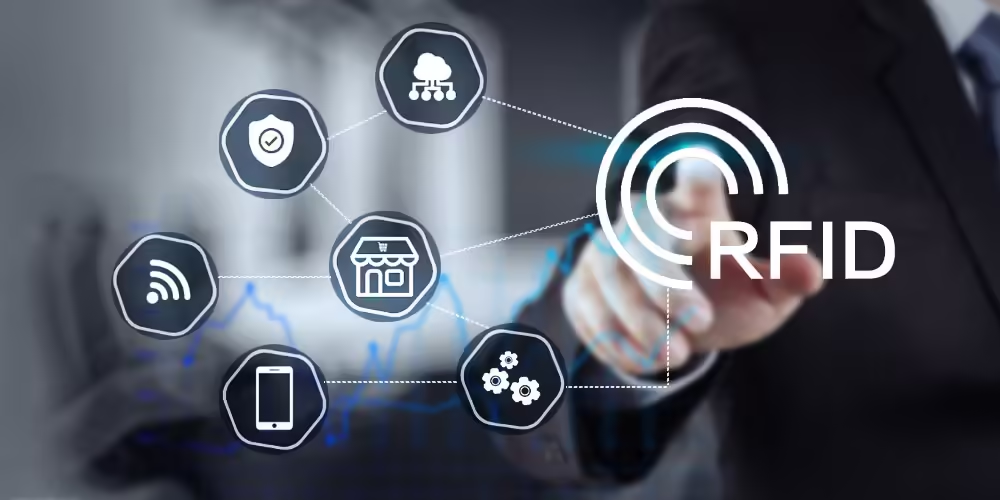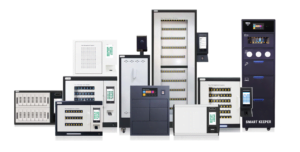What is RFID?
RFID (radio frequency identification) is a form of wireless communication that incorporates the use of electromagnetic or electrostatic coupling in the radio frequency portion of the electromagnetic spectrum to uniquely identify an object, animal or person. The principle is contactless data communication between the reader and the tag to achieve the goal of identifying the target. The application of RFID is very extensive, with typical applications including animal chips, car chip anti-theft devices, access control, parking lot control, production line automation, and material management.
How does it work?
RFID system mainly consists of three core components: electronic tag, antenna and reader.
Electronic tag: also known as transponder, located on the object to be identified, is the data carrier in the RFID system, and stores the unique identification information of the object.
Antenna: used to transmit radio signals, connect the reader and electronic tag, and realize wireless transmission of data.
Reader: used to read the data in the electronic tag and send it to the data processing system for further processing.
The working process of RFID technology is roughly as follows:
Identification process: When an object with an electronic tag enters the identification range of the reader, the reader transmits a radio signal to activate the electronic tag.
Data transmission: After the electronic tag receives the signal, it sends the stored data back to the reader through the antenna.
Data processing: After the reader receives the data, it processes it through the middleware, and finally transmits the processed data to the computer or other data processing system
What are the types of RFID systems?
RFID (Radio Frequency Identification) technology can be classified from multiple dimensions, mainly including power supply mode, working frequency, communication mode and tag chip type.
Classification by power supply mode:
Active system: This type of system has a built-in power supply and can be identified at a long distance. It is usually used in scenarios that require long-distance reading.
Passive system: Relying on the electromagnetic waves emitted by the reader to obtain energy, it is suitable for short-distance identification and has a low cost.
Semi-active system: Combining the characteristics of active and passive systems, some tags have a small amount of built-in power supply to extend the working life or enhance the signal strength.
Classification by working frequency:
Low frequency (LF) system: Working in the low frequency band, suitable for close-range identification, low cost, suitable for animal tracking, etc.
High frequency (HF) system: Working in the high frequency band, suitable for medium-distance identification, often used in access control systems.
Ultra-high frequency (UHF) system: Working in the ultra-high frequency band, suitable for long-distance identification, often used in logistics and supply chain management.
Microwave (uW) system: Works in the microwave band, suitable for ultra-long-distance identification, often used for highway toll collection, etc.
Classification by communication method:
Half-duplex system: Both parties in communication can send and receive signals alternately, suitable for application scenarios with small data volumes.
Full-duplex system: Both parties in communication can send and receive signals at the same time, suitable for application scenarios that require high-speed data transmission.
Classification by tag chip:
Read-only (R/O) tag: The stored information can only be read, not written.
Read-write (R/W) tag: Information can be read and written, suitable for scenarios that require frequent data updates.
WORM tag (one-time write): Information cannot be changed after it is written, suitable for scenarios that require high security.
In summary, the classification of RFID technology is based on different standards and requirements, covering multiple dimensions from power supply methods to communication methods to meet the needs of various application scenarios
RFID Applications and cases
RFID dates back to the 1940s; however, it was used more frequently in the 1970s. For a long time, the high cost of the tags and readers prohibited widespread commercial use. As hardware costs have decreased, RFID adoption has also increased.
Some common uses for RFID applications include:
Warehouse management
Warehouse management is a key application area of RFID technology. RFID electronic tags can effectively solve the problem of cargo information management in warehousing, allowing enterprises to understand the location and storage status of goods in real time. This technology plays an important role in improving warehousing efficiency and guiding production. Global retail giants such as Walmart and Germany’s Metro have adopted RFID technology to achieve product identification, anti-theft, real-time inventory and product expiration control, thereby greatly improving the efficiency of the logistics link.
Anti-counterfeiting and traceability
Anti-counterfeiting and traceability are important applications of RFID technology in many fields. Each product is equipped with a unique RFID electronic tag, which records all information about the product from the source manufacturer to the sales terminal. When this information is scanned, a detailed product history record is generated. This method is particularly suitable for the anti-counterfeiting of valuable items such as cigarettes, alcohol, and medicines, as well as the anti-counterfeiting of tickets. Through RFID technology, the authenticity of the product can be ensured and its source can be tracked, providing consumers and enterprises with higher trust and transparency.
Smart medical care
In smart medical care, RFID technology provides efficient and accurate information storage and inspection methods for medical monitoring. In the emergency department, due to the large number of patients, the traditional manual registration method is inefficient and error-prone. To this end, each patient is given an RFID wristband tag, and medical staff only need to scan to quickly obtain patient information, ensuring that emergency work is carried out in an orderly manner and avoiding medical accidents caused by incorrect information entry. In addition, RFID technology is also used for automatic identification and tracking of medical devices and drugs, further improving medical management and safety.
Access control and attendance
Access control and attendance are important applications of RFID technology in personnel management. Access control cards and one-card systems are widely used in campuses, enterprises and other places, and multiple functions such as identity authentication, payment and security management are achieved through one card. This system not only simplifies entry and exit procedures and improves work efficiency, but also effectively provides security protection. When a person wears a radio frequency card packaged in the size of an ID card and there is a reader at the entrance and exit, the identity of the person can be automatically identified when entering and exiting, and an alarm will be triggered for illegal intrusion. In places where the security level is high, other identification methods can also be combined, such as fingerprints, palm prints or facial features stored in radio frequency cards.
Fixed asset management
Fixed asset management is an important application of RFID technology in the field of asset management. Asset managers can conveniently conduct asset inventory by sticking or fixing RFID electronic tags on assets. In addition, using the RFID fixed asset management system, administrators can uniformly manage fixed assets, including setting information reminders for scheduled inspections and scrapping. At the same time, the system also supports asset acquisition approval and consumables management, greatly improving management efficiency and accuracy.
Smart library management
Smart libarary management is an important application of RFID technology in the library field. By embedding RFID tags in books, libraries can achieve fully automatic book borrowing, returning, inventory management and anti-theft management. This method not only avoids the tediousness of manual inventory and improves management efficiency, but also allows readers to complete book borrowing and returning through simple operations, greatly improving user experience. In addition, RFID technology can also conveniently receive book information, so that there is no need to move books when sorting books, thereby improving work efficiency and reducing work errors.
Smart retail management
Smart retail management is an important application of RFID technology in the retail industry. By attaching RFID tags to goods, the retail industry can achieve fine management and inventory monitoring of goods, thereby improving operational efficiency and customer experience. For example, clothing stores can use RFID tags to facilitate customers to pay in advance, avoiding waste of labor and costs. In addition, stores can also monitor sales in real time, conduct efficient tracing and adjustment work based on sales data, and realize real-time sales data statistics, replenishment and anti-theft functions of goods.
Electronic article surveillance system
Electronic article surveillance system (EAS) is mainly used to prevent goods from being stolen. The system mainly relies on radio frequency identification technology (RFID). Radio frequency cards usually have a 1-bit memory capacity, that is, two states of on or off. When the radio frequency card is activated and approaches the scanner at the store exit, the system will detect it and trigger an alarm. To prevent false alarms, when the goods are purchased, the salesperson will use special tools or magnetic fields to disable the radio frequency card or destroy its electrical characteristics. In addition, there are many technologies for EAS systems, including microwave, magnetic field, acoustic magnetism and radio frequency.
Pet and livestock tracking
Pet and livestock tracking is one of the most common applications of RFID technology. Many pet owners use RFID tags to track their pets to ensure they don’t get lost or stolen. These tags can be attached to pet collars or other devices so that owners can detect the pet’s location at any time through an RFID reader.
Smart transportation
RFID technology has a wide range of applications in the field of smart transportation. It can realize automatic authentication and tracking of vehicles, thereby improving the safety and efficiency of road traffic. For example, through dedicated short-range communication between the on-board electronic tag installed on the vehicle windshield and the radio frequency antenna of the toll station, the vehicle can pay the toll without stopping when passing through the road and bridge toll station. In addition, RFID technology can also be used for data collection, bus cards, parking identification, charging, taxi management, bus hub management, railway locomotive identification, air traffic control, passenger ticket identification and luggage parcel tracking.
Automotive
RFID technology has many applications in the automotive field, including manufacturing, anti-theft, positioning and car keys. In the manufacturing process, RFID technology can be used to track and manage auto parts and improve production efficiency. In terms of anti-theft, RFID technology is integrated into the car key, and the identity of the key is verified by the reader/writer to ensure that the car engine will only start when a specific signal is received. In addition, RFID can also be used for vehicle positioning and tracking to improve the accuracy and efficiency of vehicle scheduling. These applications not only improve the safety and convenience of automobiles, but also promote innovation and development in the automotive industry.
Military/defense management
Military/defense management is an important application field of RFID technology. In military environments, RFID technology is used to identify and track various materials and personnel, such as ammunition, guns, materials, personnel and trucks. This technology provides an accurate, fast, safe and controllable technical approach for military/defense management, ensuring dynamic real-time tracking of important military medicines, guns, ammunition or military vehicles.
Logistics and supply chain management
RFID technology plays a key role in logistics and supply chain management. It uses RFID tags or chips in transportation and warehouse environments to achieve real-time tracking of items, including information such as location, quantity and status, thereby optimizing logistics processes and reducing manual operations. In addition, RFID technology can also automatically perform inventory counting and distribution management, further improving efficiency and transparency. This technology not only improves the efficiency and accuracy of supply chain management, but also reduces costs and error rates.
Rental product management
RFID technology has a wide range of applications in the field of rental product management. When electronic tags are embedded in rental products, product information can be easily received, so that there is no need to move physical objects when sorting or counting products, which greatly improves work efficiency and reduces human errors. This technology not only simplifies the inventory management process, but also enhances the tracking and identification capabilities of products, providing a more reliable and efficient solution for the rental business.
Airline package management
Airline package management is an important application area of RFID technology. The global aviation industry pays up to $2.5 billion each year for lost and delayed baggage. To address this problem, many airlines have adopted wireless radio frequency identification systems (RFID) to strengthen the tracking, distribution and transmission of baggage, thereby improving security management and avoiding the occurrence of misdelivery. RFID electronic tags can be simply integrated into existing baggage tags, check-in printers and baggage sorting equipment to automatically scan baggage and ensure that passengers and checked baggage arrive at their destination safely and on time.
Manufacturing
RFID technology has a wide range of applications in the field of manufacturing. First, it can achieve real-time monitoring of production data to ensure the transparency and controllability of the production process. Secondly, RFID technology can be used for quality tracking to ensure that the quality of products is controllable throughout the entire production process from raw materials to final products. Finally, through RFID technology, automated production processes can be achieved, which not only improves production efficiency, but also greatly reduces the possibility of human errors. These applications make RFID technology an indispensable technology in the field of manufacturing.




